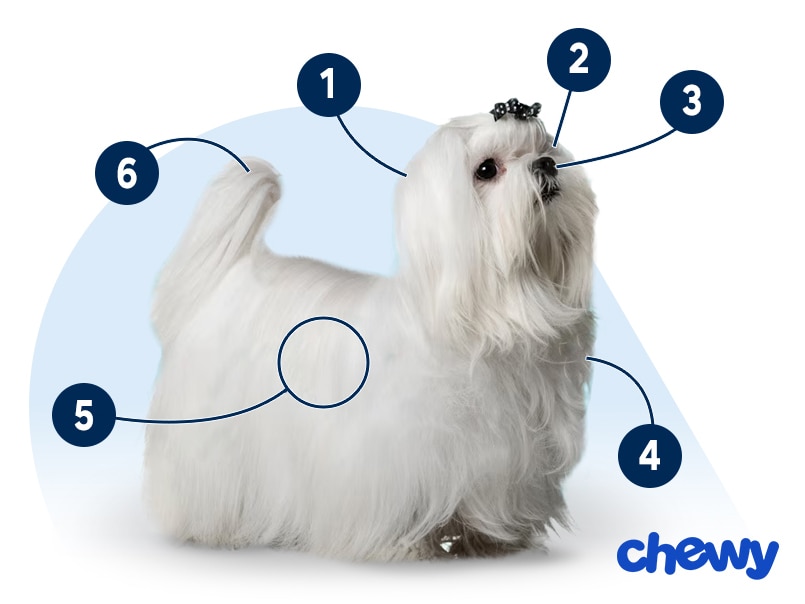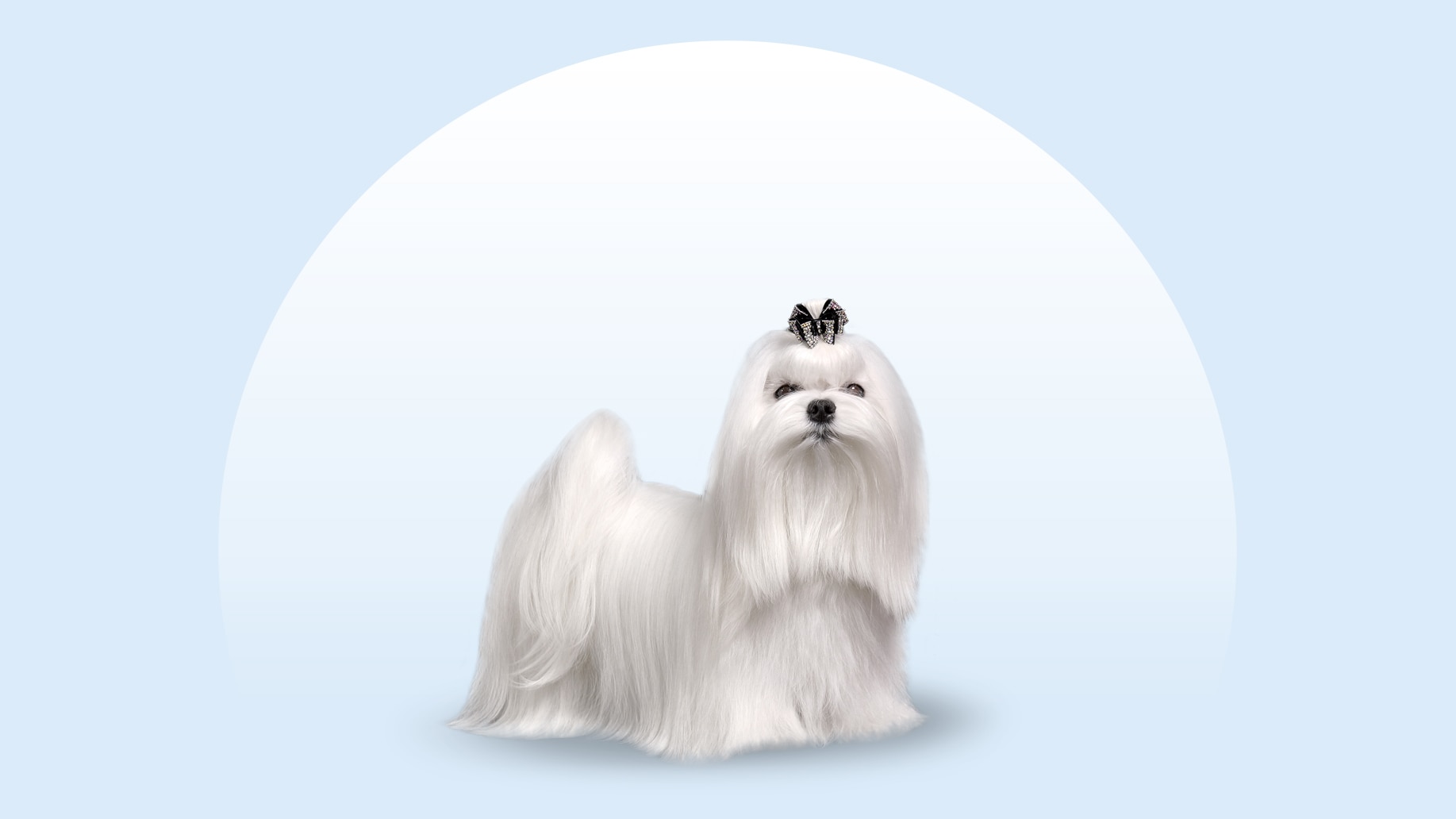Maltese
Updated March 21, 2025
Maltese
Updated March 21, 2025
Known for their bright white coat, the Maltese is permanently happy—as long as you’re around to offer friendship and affection. With a history of courting nobility, this kind little dog is a delightful and charming companion.
Charismatic, Friendly, Gentle
under 7 pounds
7–9 inches
12–15 years
White
Maltese are so cute they should probably be on magazine covers, but this plucky dog is too down-to-earth to be stuck-up about how adorable they are. Most likely, they’ll be more concerned with making sure their new best friend (that’s you) is happy.
These petite pups have been known to court queens, so consider it an honor if one has chosen to be your bestie, too. You can repay your Maltese by taking them with you to the office, to brunch, or anywhere they’re welcome. They’re delightful companions who are eager to impress.
Maltese Characteristics
Maltese Appearance
The Maltese is a small dog with dark, friendly eyes; a small black nose; and white fur. While they traditionally have a long, silky coat, some pet parents give these dogs short haircuts, which are equally charming.

- Ears
The Maltese’s feathery ears hang low and are covered with long hair. Although typically white, their ears might also have tan or lemon colors.
- Eyes
The Maltese dog’s eyes are dark and friendly, with a gentle, round shape. Their eyes pop amongst all that white fur.
- Nose
They have a gumdrop-shaped black nose that stands out against their all-white coat.
- Coat Length
The Maltese breed’s silky, single-layered coat grows to be floor-length unless trimmed into a cute haircut.
- Coat Color
A Maltese coat is white, though their ears might have a light tan or lemon color.
- Tail
A Maltese dog’s tail is a long, silky plume carried gracefully over their back. The tip of the tail rests on the side of their back end.
Maltese Temperament
Maltese have a love for laps and their people. Their favorite place is to be wherever you are, and although they’re not among the most energetic breeds, they are lively and playful little dogs.
These friendly pups are fairly outgoing and generally get along well with other pets, provided they are properly trained and socialized with other animals. Their small size does make them fragile, so they should always be supervised around young tots and babies to make sure they’re not overwhelmed by children who mistake them for a plushie.
The tiny Maltese has a sweet personality that makes them great therapy dogs. But more than anything else, they just want a chance to sit in your lap and be close to you.
How to Care for a Maltese
The Maltese personality is not high-maintenance, but their grooming will need your attention. They don’t have extensive exercise needs, so use that extra time to give their coat some TLC.
And even though they love being in your lap, they need to explore the world on their own, so physical and mental enrichment are a must.
Grooming
Training
Diet
Exercise
Environment
Maltese Health
A Maltese lifespan is 12–15 years. Here are some potential health issues to be aware of.
- Acquired tremors syndrome: Also known as shaker syndrome, this condition affects mostly small white dog breeds (though small dogs with other coat colors can have it, too). Dogs with this syndrome may have mild tremors in one body part or more severe tremors all over that make it difficult for them to walk. This condition is usually treated with prednisone.
- Cataracts: Cataracts aren’t usually painful, but they can cause cloudy eyes and vision loss, so get a yearly eye test to catch them early. Surgery is the go-to treatment.
- Epiphora: Epiphora is another name for watery eyes, and it contributes to tear stains. Most tear staining isn’t a cause for concern, but if your pup is tearing up more than normal, it could be the result of an underlying health condition like allergies, corneal ulcers, dry eye syndrome, or another eye disease. Contact your vet if you think something may be up.
- Glaucoma: Glaucoma occurs when fluid in the eyes doesn’t drain and pressure builds. It’s painful and can result in blindness, so it’s a medical emergency. Treatment is topical medications or surgery.
- Granulomatous meningoencephalitis (GME): GME is a complex condition that affects the brain and spinal cord. While there is no cure, the condition is often treated for life with steroids or immunosuppressive drugs.
- Hypoglycemia: Low blood sugar is common in Maltese dogs. Feed your dog on a regular schedule to prevent hypoglycemia; your vet can give you advice.
- Luxating patella: Maltese can develop a luxating patella, where the kneecap slips out of place. It may be treated with supplements and meds, if mild, though surgery may be necessary. Keeping your dog at a healthy weight can help prevent this condition.
- Patent ductus arteriosus (PDA): PDA is a congenital heart defect in dogs. It’s when a blood vessel near the heart doesn’t completely close after birth, and it can lead to heart failure. It can often be corrected with surgery.
- Portosystemic shunt: Also called a liver or hepatic shunt, a portosystemic shunt is when blood vessels circumvent the liver, preventing it from clearing the blood of toxins. Surgery is often the best treatment.
- Progressive retinal atrophy (PRA): PRA leads to blindness in dogs, and while there is no cure, pups who lose their eyesight tend to adapt well and can still live full, happy lives.
- Tracheal collapse: Tracheal collapse happens when a dog’s windpipe flattens. It makes it hard to get air into the lungs, and as a result many dogs may make a dry, goose-like honking cough. Pups with this condition should have their leash attached to a harness, not a collar (which can push on the trachea), and treatment may include weight management, medications, or surgery.
Maltese History
The Maltese has a long history as a beloved lapdog, and they take their name from the island of Malta in the Mediterranean Sea.
From 1500 B.C.E., Malta was conquered by different empires for two millennia, and it’s thought that Phoenicians (who were around before the rise of Greece) introduced them to the island.
The dogs were well-loved in Greek culture in the 4th and 5th centuries; they were depicted in art and praised by Aristotle for their symmetry. They were a status symbol for ancient Romans, and there is even a legend that Saint Paul was given a Maltese after he was shipwrecked on Malta.
When the Roman Empire collapsed and ushered Europe into the Dark Ages, the Maltese breed thrived in China, where the dogs were crossed with native breeds; later, they became popular again in Europe and were owned by nobility, notably Mary, Queen of Scots and Marie Antoinette.
A Maltese puppy can cost as much as $4,000. If you choose this route, pick a responsible breeder.
You can also look for Maltese dogs for adoption. Seek out a local Maltese rescue like the American Maltese Rescue Association, keep an eye out at your local shelter, or search Chewy’s database of adoptable dogs in your area.




















